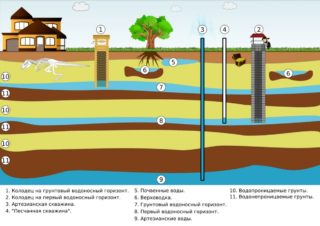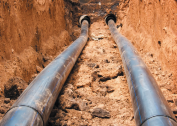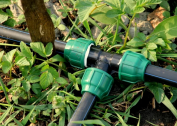To provide a private house with water, you need to equip a well or well. At the same time, you can encounter several types of groundwater, each of which is intended for specific purposes: watering the garden, eating. In order for a well to function well, it is important not only to determine its location correctly, but also to gain access to quality water. To do this, you need to know how various types of sources work.
Aquifer classification
The deeper the aquifer is, the cleaner the water in it. The soil is not homogeneous in its composition - clay or stone water-resistant formations alternate with friable substances - sand, marl, silt or limestone. Sand is closer to the surface, limestone lies deeper.
It is difficult to choose the ideal place for the well, since in each region the layers are located differently. To determine where there is a water vein, different methods are used, including folk ones - they are determined by the type of plants, a vine, a barometer are used.
When drilling a well, the following types of groundwater can be detected:
- High vault. These are limited areas that are surrounded on all sides by water-resistant formations. The liquid can be used for technical purposes, since all chemicals enter it - the filter layer in such areas is very small. The minus of the water trap is that it is fed by rains, and in the summer heat the level decreases significantly. It is impossible to drink such water without preliminary preparation.
- Groundwater is located below. Since there is a large layer of soil on top, the fluid is cleaner and more transparent. Its quantity depends on the season - in spring and autumn, the level rises, in summer - decreases. Sand beds are better filled with water in the forest, but in open areas, the liquid can completely disappear in the hot season.
- Interstratal water deposits are located between two water-resistant horizons. They are located at a depth of 20 to 80 m under pressure, which is why liquid is sometimes ejected during drilling.
- The artesian aquifer belongs to a variety of interstratal. They are also characterized by increased pressure. The plus of the well drilled to the artesian layer is that the fluid level in it is always the same. Moreover, under the influence of pressure, the water mirror is high. The liquid is suitable for use without additional filtration.
Before starting drilling, it is necessary to make several test mines and take the liquid for analysis to determine the quality of the water - it is suitable for human consumption or needs to be subjected to additional cleaning.
Types of wells
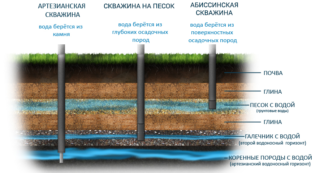 There are several main types of water wells:
There are several main types of water wells:
- Abyssinian;
- sandy;
- limestone.
There are still wells, but their arrangement is associated with increased labor costs and funds. Sometimes you need to use heavy construction equipment, which affects the budget. Water from a well most often requires additional preparation before use due to the flow of fluid from the upper layers of the soil.
Norton Well or Abyssinian Well
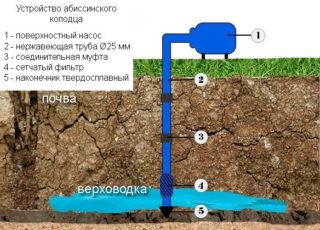 To realize such a source on the site in one day. Features and advantages of a well without caisson:
To realize such a source on the site in one day. Features and advantages of a well without caisson:
- The sharp-pointed pipe does not screw in, but clogs into the soil.
- Below are the filter holes through which fluid enters the pipe, and is pumped out from there.
- The place where the holes are located can additionally be wrapped with geotextiles to prevent sand and dirt from entering the water.
A caisson is necessary if it is planned to connect a pumping station that pumps water up to 8 meters.
The depth of the abyssine is up to 20 meters, the diameter of the pipe is not more than 6 cm. In places where the soil is rocky or clay, the Abyssinian well is not made, since the tip will not be able to break through stone or clay. The most successful solution is sand. It is better if the abyssine reaches ground water - in this case, the liquid is suitable for drinking.
If you cannot connect an electric pump, a lever is made into the well and the water is pumped manually. This option is suitable for suburban areas, since the flow rate of the source is small - up to 1 cubic meter per hour.
Well in the sand
 The sandy aquifer is deeper and provides a clear liquid theoretically suitable for drinking. It all depends on where the site is located and how far the agricultural land that is watered with chemicals is located. If there is no cesspool near the bottom without a bottom, water is more likely to be clean.
The sandy aquifer is deeper and provides a clear liquid theoretically suitable for drinking. It all depends on where the site is located and how far the agricultural land that is watered with chemicals is located. If there is no cesspool near the bottom without a bottom, water is more likely to be clean.
A well on sand is deeper than Abyssinian - up to 40 meters. When drilling, a casing is used to strengthen the walls. Sandy soil is very mobile, so they try to immediately close the drilled area with a casing.
Apply various materials - metal, plastic, concrete. Metal in a sand well rusts faster, plastic is not so strong as to withstand the movement of the soil. It is not recommended to place a plastic casing at a depth below 25 meters. The best option is plastic in metal or concrete.
Sand sources are the most common due to the optimal combination of water quality, installation costs and the amount of liquid sufficient to provide a private house.
Limestone well
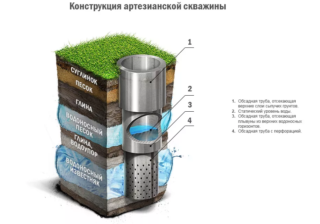 If the fluid from the soil surface passes through many layers, it is well cleansed and saturated with minerals. The artesian well is deep - over 40 meters, although in high mountain regions you can find an artesian layer at a depth of 25 meters.
If the fluid from the soil surface passes through many layers, it is well cleansed and saturated with minerals. The artesian well is deep - over 40 meters, although in high mountain regions you can find an artesian layer at a depth of 25 meters.
Serious requirements are placed on the arrangement of wells on limestone - the method of drilling, materials for the casing. The lifetime and water quality will depend on this. For example, no company recommends the use of plastic pipes, since they are easily deformed, and it will be impossible to replace them at a depth of about 100 - 200 m. To understand how an artesian mine behaves, we can take an example of the deepest well in the world, located on the Kola Peninsula. The shift of the trunk is over 840 meters, that is, the neck is not directly above the lowest point, but 840 meters to the side.
The liquid level is always the same and does not depend on the time of year. There is no need to clean or repair it. In fact - you need to invest only in construction, and then use the object for over 50 years. The flow rate of the well allows you to equip it for water supply of several houses. Such a source can produce over 10 cubic meters of water per hour.
Which well is better to equip on the site
Most often, residents are guided by the cost of working materials. Self-drilling is sometimes chosen to save money. This is justified if the aquifer is high and the soil in the region is soft. An Abyssinian well or well on sand will cost less than an artesian source.
If the depth of the water vein is large, and clay layers or stones are found in the soil, you will have to overpay construction companies specializing in drilling. Building a water heater is not an option, as more money will subsequently be spent on filtering water or bringing it from other sources if the level suddenly drops in the summer.
Artesian types of wells have no drawbacks, but are very expensive, so you can cooperate with your neighbors if the issue of water supply is also open for them.
